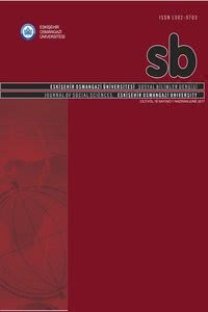Fundamental Analysis With Neuro-Fuzzy Technology: An Experiment in Istanbul Stock Exchange
Bulanık-Sinirsel Ağ ile Temel Analiz: İMKB'de Amprik Bir Çalışma
___
- Abarbanell J.S., Bushee, B.J. (1997). Fundamental analysis, future earnings, and stock prices, Journal of Accounting Research, 35(1): 1-24.
- Abarbanell, J.S., Bushee B.J. (1998). Abnormal returns to a fundamental analysis strategy, The Accounting Review, 73(1): 19-45.
- Carter R.B., Van Auken H.E. (1990). Security analysis and portfolio management: a survey and analysis, Journal of Portfolio Management, 16(3) : 81-85.
- Houltsen, R.W., Larcker, D.F., (1992). The Prediction of stock returns using financial statement information, Journal of Accounting and Economics, 15(2-3): 373-411.
- Jang, J.S.R., Sun C.T., Mizutani, E., (1997). Neuro-Fuzzy and Soft Computing, Prentice Hall PTR, NJ.
- Kimoto, T., Asakawa, K., Yoda, M., Takeoka, M. (1996). Stock Market Prediction System With Modular Neural Networks, In Trippi R. R., Turban E., Neural Network in Finance and Investing, Irwin Professional Pub., Chicago,1996, pp. 497-510.
- Kothari, S.P. (2000). Capital markets research in accounting, Journal of Accounting and Economics, 31(1-3): 105-231.
- Kryzanowski, L., Galler M., Wright,D.W. (1993). Using artificial neural networks to pick stocks, Financial Analysts Journal, 49(4): 21-27.
- Kryzanowski, L., Galler, M. (1995). Analysis of small-business financial statements using neural nets, Journal of Accounting, Auditing and Finance,10(1), 147-172.
- Leigh, W. , Paz,M., Purvis, R. (2002). An analysis of a hybrid neural network and pattern recognition technique for predicting short-term increases in the NYSE composite index, Omega, 30(2): 69– 76.
- Lev, B. Thiagarajan R., (1993). Fundamental information analysis, Journal of Accounting Research, 31 (2): 190-215.
- Nauck, D., Kruse, R., (1999). Obtaining interpretable fuzzy classification rules from medical data, Artificial Intelligence in Medicine, 16(2):149-169.
- Ou, J.A., Penman, S.H. (1989). Accounting measurement, price-earing ratio, and the information content of security prices, Journal of Accounting Research, (Supplement to 1989), 111-144.
- Quah, T.-S, Srinivasan, B.(1999). Improving returns on stock investment through neural network selection, Expert Systems with Applications, 17(4) : 295- 301.
- Siekmann, S, Kruse, R., Gebharddt, J. (2001). Information fusion in the context of stock index prediction, International Journal of Intelligent Systems, 16(11): 1285-1298.
- Tsaih R., Hsu Y., Lai C. C. (1998). Forecasting S&P 500 stock index futures with a hybrid AI system, Decision Support Systems, 23(2): pp. 161–174.
- Wong, M.C., Cheung, Y-L. (1999). The practice of investment mangement in Hong Kong: market forecasting and stock selection, Omega International Journal of Management Science, 27(4): 451-465.
- Wong., F.S., Wang, P.Z., Goh, T.H., Quek, B.K. (1992). Fuzzy Neural Systems for Stock Selection, Financial Analysts Journal, 48(1): 47-52.
- Wood, D., Dasgupta, B. (1996). Classifying trend movements in the MSCI USA capital market index- A Comparision of regression, ARIMA and neural network methods, Computers and Operations Research, 23(6): 611-622.
- Zadeh, L.A. (1965).Fuzzy sets, Information and Control, 8(3):338-353.
- Yayın Aralığı: 3
- Başlangıç: 2000
- Yayıncı: -
ŞAİR ÖZDEMİR İNCE’NİN YAZILARI VE YAZARLIĞI
BALIKESİR İLE TÜRKİSTAN’DA DEPREM VE TEVFİK FİKRET’E SİTEM
BULANIK-SİNİRSEL AĞ ILE TEMEL ANALIZ: İMKB’DE AMPRIK BIR ÇALIŞMA
RİDİT ANALİZİ VE ÜNİVERSİTE ÖĞRENCİLERİNİN GELECEK KAYGILARININ İNCELENMESİ ÜZERİNE BİR UYGULAMA
GELİŞME VE DEMOKRASİ: KALKINMAYLA DEMOKRATİKLEŞME YA DA KALKINMANIN DEMOKRATİKLEŞTİRİLMESİ
COĞRAFYA DERSİ ÖĞRETİM PROGRAMI-2005’E ELEŞTİREL BİR BAKIŞ
Halil İbrahim Taş and Alaattin Kızılçaoğlu, Halil İbrahim TAŞ, Alaattin KIZILÇAOĞLU
Ridit Analizi ve Üniversite Öğrencilerinin Gelecek Kaygılarının İncelenmesi Üzerine Bir Uygulama
